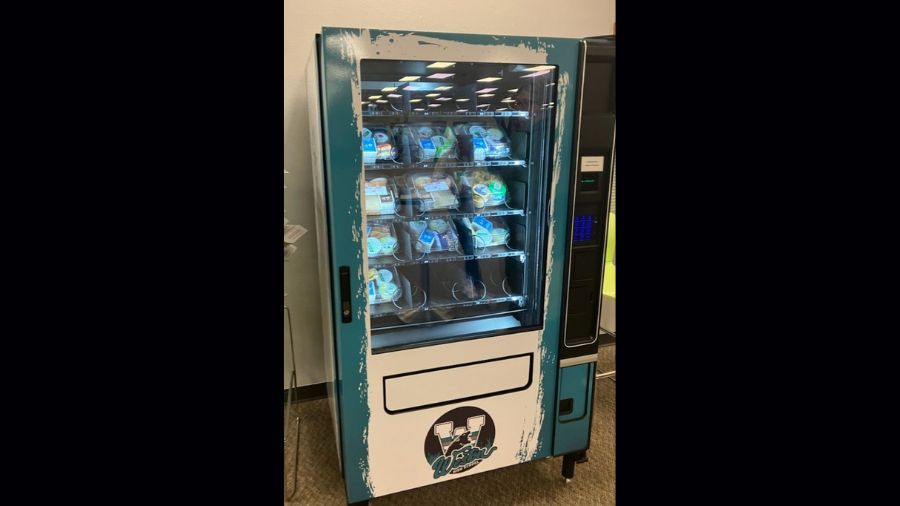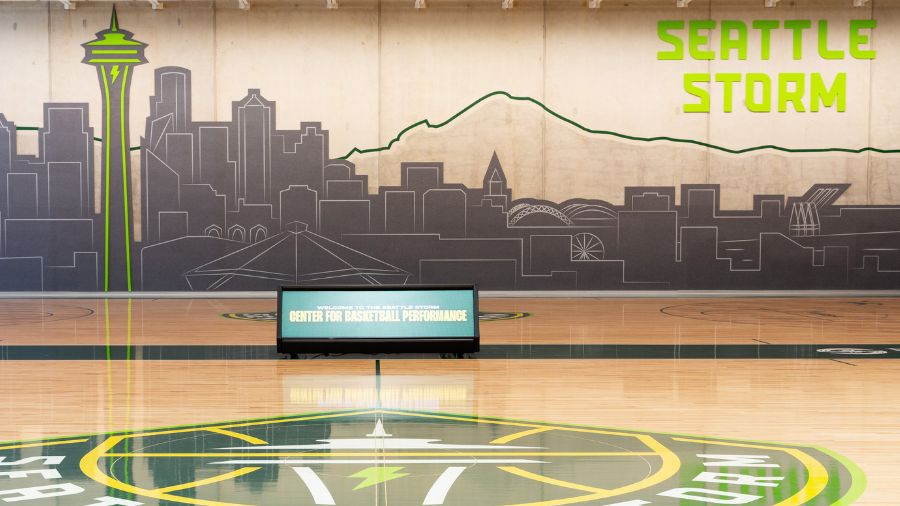The story behind historic gargoyles found in Seattle’s Civic Arena
Mar 29, 2017, 7:09 AM | Updated: Oct 4, 2022, 2:25 pm

One of two gargoyles from the Civic Arena demolition in Seattle Center that were supposed to be preserved. (Photo courtesy Seattle Opera.)
(Photo courtesy Seattle Opera.)
UPDATE, 4/9/19: Historic gargoyles from the old Civic Arena that the City of Seattle and Seattle Opera promised to preserve ended up being taken to the dump. More details tomorrow on Seattle’s Morning News during Feliks Banel‘s regular history feature.
Original story published March 29, 2017
When KIRO Radio first reported that demolition was underway on the Mercer Arts Arena, a building at Seattle Center along Mercer Street originally dating to 1928, the story included unanswered questions about what might be hidden behind newer portions of the structure added for the 1962 World’s Fair.
RELATED: Sidewalk artifact is relic of forgotten Seattle company
Speculation among a few members of the historic preservation community was that some or all of the original 1928 façade might be hiding behind a series of brick walls. Various groups involved with the project – Seattle Opera, Seattle Center and several consultants – assumed the 1928 façade had been mostly demolished as part of the remodel 55 years ago.
The questions were answered and the mystery was solved on Thursday, when demolition crews razed a portion of a brick wall built in 1961 and revealed – and then quickly demolished – the intact 1928 original façade of the old Civic Arena.
Crosscut writer and “Mossback” columnist Knute Berger caught a glimpse of the action in progress.
“When I saw the gargoyles coming down, I had no idea they were there,” Berger said. “And I thought, ‘Somebody screwed up.’”
The portion of the 1928 façade that was revealed by the demolition included original doorways, arches, medallions and two pedestals, all of which had been secreted away behind the 1961 brick wall for more than 55 years. The 1961 wall was built to “modernize” the look of the Arena and the neighboring Civic Auditorium (now McCaw Hall), and give a consistent appearance to the fairgrounds along Mercer Street.
Passersby watching the demolition on Thursday witnessed the 1928 façade as it saw the light of day for the first time in more than half a century. Within minutes, those same passersby saw much of the 89-year old façade knocked down.
What really caught the eye of Mossback and many people there along Mercer Street in person (and raised the ire of countless others on social media, where Q13’s Facebook livestream of the Arena had more than 50,000 views and hundreds of shares and comments) were two gargoyles that were knocked from their pedestals by the demolition crew within moments of their having been uncovered.
The seemingly needless destruction of the long-hidden gargoyles has become something of a symbol of what happened on Thursday in spite of years of preparation by Seattle Opera for demolishing the Arena, a publicly owned facility they describe on their website as “an unused building now blighting the Seattle Center campus.”
Why the Seattle Center gargoyles fell
KIRO Radio had first contacted Seattle Opera earlier in March with questions about what might remain of the old 1928 building behind the 1961 brick wall. Seattle Opera has been a tenant in the Arena for nearly 15 years and is tearing it down to make room for their new headquarters. The Arena was included in a city-funded 2013 survey of potential Seattle Center landmarks carried out by a Tacoma firm called Artifacts, Inc., but it was left off a list of recommendations of buildings that were worthy of preservation.
Opera spokesperson Kym Michela said last week – before the 1961 brick wall was breached – that the project team believed there was little or nothing of the original building’s ornamentation left.
In an email to KIRO Radio last Tuesday, Michela wrote:
“I spoke to [demolition project manager] Ken [Johnsen] and he said that the building was significantly altered for the 1962 World’s Fair . . . The ornate frontage is all gone and the roof-line was dramatically changed so there are no original 1927/1928 elements.”
The Opera had the blessing of Seattle Center and the historic preservation staff of the Seattle Department of Neighborhoods – and a permit in hand – to tear down the old Arena based on a review of the structure’s architectural and historic significance conducted over a few days last summer.
The Seattle Opera hired a firm called HRA, Inc. to conduct an evaluation of the Arena as part of the process for securing a demolition permit. HRA’s report was submitted to the Seattle Landmarks Preservation Board (part of the City of Seattle Department of Neighborhoods) on July 20, 2016. Two days later, the Landmarks Preservation Board issued a letter addressed to Seattle Center, known as a “Determination of Non-Significance” (or DNS) that meant the demolition permitting process could go forward.
The DNS found the building lacking in significance – and thus eligible for demolition – mainly because of alterations to the adjacent McCaw Hall (former Opera House/Civic Auditorium) that cut off the Arena from other World’s Fair-related Seattle Center buildings. The existence and intact condition of the 1928 Civic Arena façade was not addressed in the DNS because it wasn’t mentioned in HRA, Inc.’s report.
Heather Miller is a Senior Historian in HRA, Inc.’s Seattle office. She conducted the evaluation of the Arena, which included examining original 1928 plans and the 1961 remodeling plans, and making a visit to tour and inspect the building last July.
Miller’s report, known as “APPENDIX A: Mercer Arts Arena, Seattle Center,” makes no mention of even the possibility that the 1928 façade might be hiding behind the 1961 brick wall.
In fact, the language is fairly unequivocal in its assessment of the condition (or the presence or lack thereof) of the structure’s original decorative elements:
“On the primary, north façade, facing Mercer Street, the central group of three entrances . . . were retained . . . The entire façade was altered by the brick wall, which covered the articulated piers and windows . . . All other exterior ornamental features were eliminated, except for four wall-mounted original light fixtures.”
Reached by phone at an out-of-state conference Tuesday afternoon, Miller said she examined the structure as thoroughly as was possible. She said she poked around the upper floors and on the roof, and looked at a small and unadorned portion of the 1928 façade that was visible on the second floor at the east end of the north wall of the building.
She didn’t find the ornately decorated portion of the façade that was revealed intact on Thursday – the part that included the gargoyles, pedestals and medallions. Miller says there was no way to do that, and that it would’ve been impractical or even dangerous to try and access that part of the building.
Miller was asked if the unique history and circumstances of the Arena – a 1928 building (a fairly rare example of Romanesque Revival architecture), with a brick “box” built in 1961 around its original footprint, with oddly thick walls where the original façade was known to have once stood – warranted a more extreme search. She didn’t think so.
Pressed as to whether it would’ve been better for all parties concerned if she had found the 1928 façade as part of her evaluation, Miller demurred. She said a more appropriate question is: Would finding it have made any difference to the ultimate outcome of the process?
“I don’t think that finding that façade would have changed the recommendation [the Seattle Landmarks Preservation Board’s ‘Determination of Non-Significance’], because when you’re doing an evaluation of significance and integrity, what you’re looking at is what the building currently is,” Miller said. “And what it currently is, is not its 1928 incarnation.”
And what about the feasibility of preserving the original 1928 Civic Arena façade — had it been discovered before it was demolished last week?
“Unless you were to peel back, very carefully, all of the 1961 façade . . .” Miller’s voice trailed off. “Would it have been cool? Sure. Would it have changed anything? I don’t think so.”
Could the outcome have been different?
Lois Maag is a spokesperson for the Department of Neighborhoods (DON). Via a series of emails on Tuesday, she responded on behalf of Sarah Sodt, the City of Seattle’s Historic Preservation Officer, to multiple questions: whether the Landmarks Preservation Board is satisfied with their process and the result — as far as the Arena is concerned — and if the ultimate outcome of their work – a “Determination of Non-Significance” and, ultimately, a demolition permit – would have been different if the 1928 façade had been included in HRA, Inc.’s report.
“We can only base our evaluation on the information available from HRA’s report and our familiarity with the interior and exterior of the building as it existed at the time of our review in 2016,” Maag wrote. “Anything else would be speculation.”
“Eligibility [for significance and potential landmark status] is assessed using the existing condition at the time of the assessment,” Maag wrote. “We expect that the cultural resources professional (in this case HRA) will provide thorough information about the resource.”
A follow-up question sent to Maag midday Tuesday — From the Department of Neighborhood’s perspective, did HRA, Inc. provide this “thorough information”? – had not been answered as of late Tuesday evening.
Meanwhile, Seattle Opera’s Kym Michela said in an email late last week, “We were not aware of the condition or full existence of the 1928 structure . . . Seattle Opera is using a pause in the demolition schedule to document the north wall and have historical photographs taken for archival purposes.”
Along with recommendations for which buildings should be preserved, the 2013 survey by Artifacts, Inc. of potential landmarks at Seattle Center also includes a line that seems at least partly applicable to the 1928 façade of the old Civic Arena:
“As buildings are adaptively reused, the potential to salvage and reuse elements from the buildings to the benefit of Seattle Center’s overall visual character should be considered.”
Last Friday, KIRO Radio examined original 1928 plans for the Arena (which are included in HRA, Inc.’s APPENDIX A: Mercer Arts Arena, Seattle Center) and identified a total of what appeared to be four gargoyles on the north wall. Kym Michela was immediately contacted about the possibility of preserving the remaining two, should they actually be there, and should they still be in salvageable condition.
On Monday, Michela confirmed that there are indeed two additional gargoyles intact, and that they will be preserved and donated to the City of Seattle.













